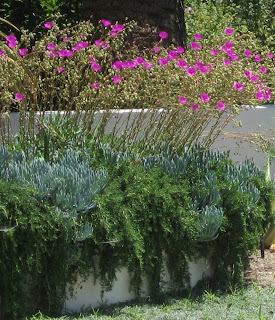Back by popular demand! I have been flooded with requests lately to either entirely get rid of, or partially remove, people's lawns. Everyone gets that lawn is very water greedy, but after that there seems to be a lot of confusion. If you take out the lawn, what goes in its place? How can you possibly occupy so much space without a lawn? And how do you actually take it out?
At my own home we removed all lawn from our yard and replaced it with two small terraced patios. We added a new low decorative fence to add a perception of privacy from the street without cutting ourselves off from our neighbors. The larger of the two patios is for a table and chairs, and we use it multiple times a week for an alfresco dinner or just to have a drink and enjoy the cool evening air. Many of my favorite plants are very florific drought tolerant species, so while most of the leaves have a grey cast to them, you'll always find something blooming in our garden. Right now it is Penstemons, flower carpet roses, sages, and lantana.
A few things to pay special attention to if you decide to remove your lawn:
1) Unless you want to be fighting grass that springs up everywhere you add water, you will need to properly kill your grass, not just physically dig it out. Roots left in the soil can and will germinate if you try to do it the easy way. Instead, get your lawn as healthy as possible by turning the water back on a spending about two weeks getting it as healthy as possible. Then spray it with roundup once a week for three weeks. Roundup is drawn into the plant as it photosynthesizes, so spraying a dead lawn won't work.
Many people do not like the idea of spraying a chemical on their yard, which I can understand. I am okay with Roundup because it does biodegrade and therefore does not harm the water table. However, if you don't want to use roundup, you will need to cover your lawn with opaque black plastic for 3-4 months. Hold the edges down with heavy stones or bricks. It takes this long to ensure that you kill all of the underground roots. I still do not find this way to be as effective, but many people swear by it.
2) Try to avoid the temptation of artificial turf. Really, even the best artificial turf is still a carpet of plastic in your yard. It uses fossil fuel based resources, often isn't recyclable, and can become quite hot in the sun (adding to the urban heat island effect). Instead, consider other lawn alternatives such as yarrow, dymondia, or thyme. All of them are drought tolerant, quick growing, and attractive, but none can take as much foot traffic as lawn, so think about adding a walkway through a high traffic area.
3) Consider switching the focus to outdoor living. Instead of a lawn, focus your garden around a patio with a table and chairs, a bench, a birdbath/feeder, or a small fountain. Think about being in the space, not just looking at it, even in your front yard! Use it as an excuse to enjoy our beautiful San Diego weather and maybe even meet a few of your neighbors. Our short fence gives us just enough of a feeling of privacy while still allowing people to chit chat as they walk past.
4) Think about edibles. Plenty of edible plants and herbs are drought tolerant. A great low water use herb garden could have rosemary, thyme, oregano, sage, bay, yarrow, and savory.
Sage Outdoor Designs is a San Diego landscape design firm. Our Principal, Kate Wiseman, has been a San Diego landscape designer for the past ten years- ask how she can help transform your garden into the one you always wanted.















